event blog 1: Particulates by Rita McBride

For this event blog, I attended Rita McBride’s Particulates on April 12, 2023. This was my first time at the Hammer Museum, and I was really excited to attend this exhibit after reading up on it online. According to the description, the installation is composed of the concurrence of water, dust, and lasers (Hammer Museum 2023). When I entered the installation room, it was incredibly dark; this darkness juxtaposed the intensity of the bright green lasers. Along with this, the room was very stuffy and moist as a result of the density of water in the air and on the ground. This actually made me laugh because it made my previously straightened hair curl up immediately. The installation is huge; the lasers dominate the room—converging to create a complex, braided assortment of light. The room is vast, and there are huge windows parallel to the installment. Compared to the concrete city outside, the exhibit poses a stark contrast. Though it exists with...
